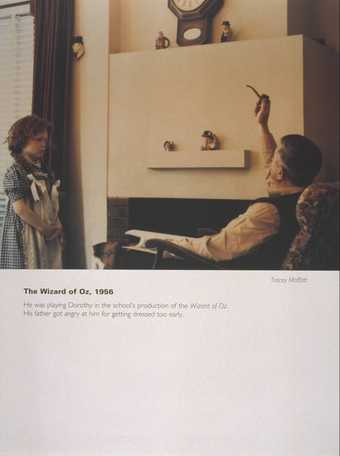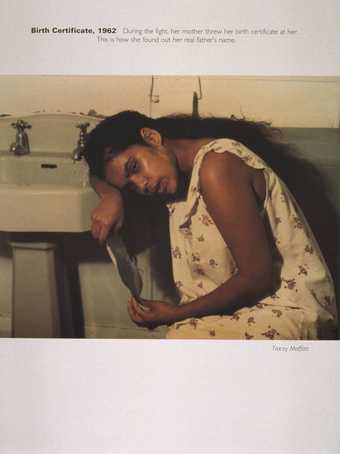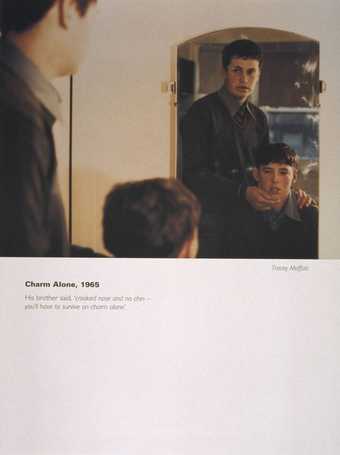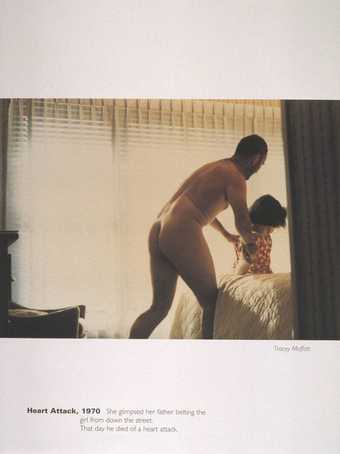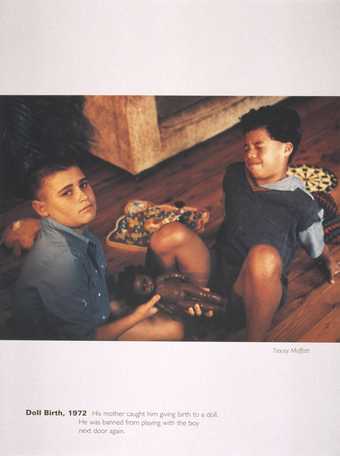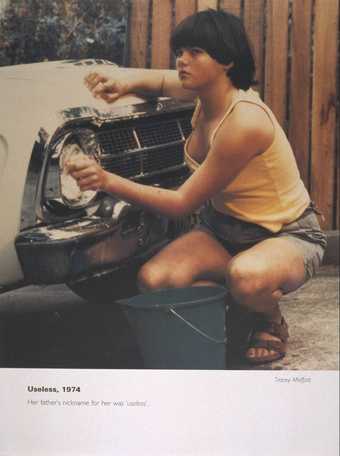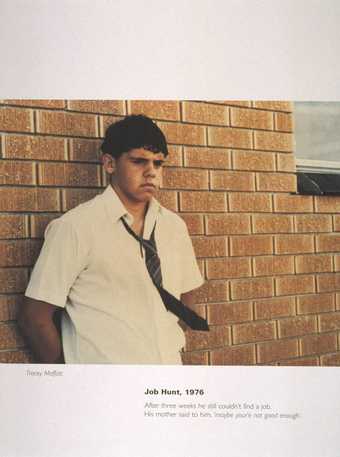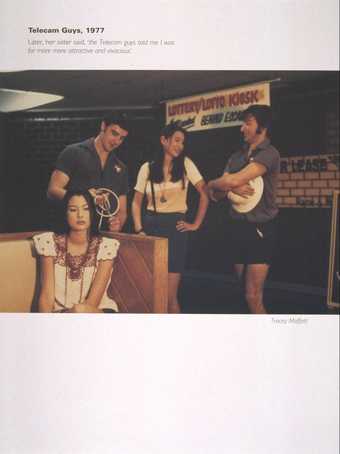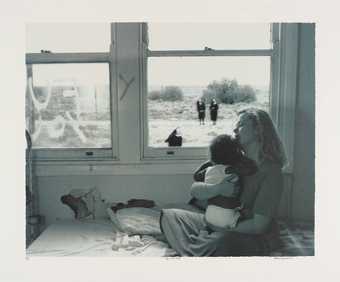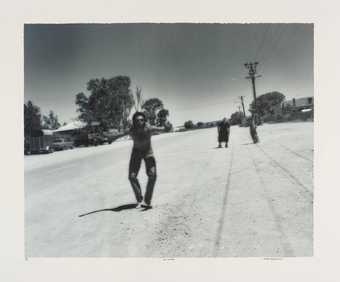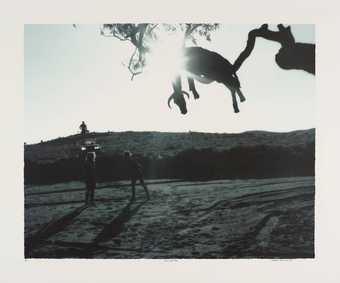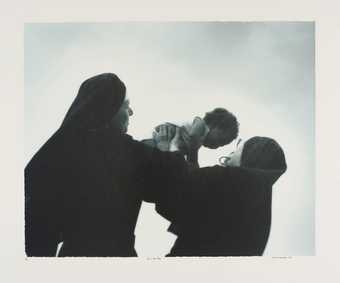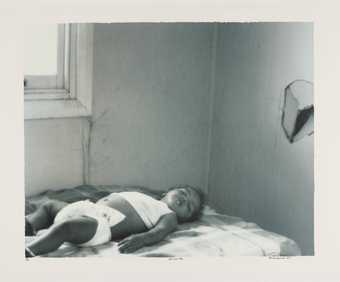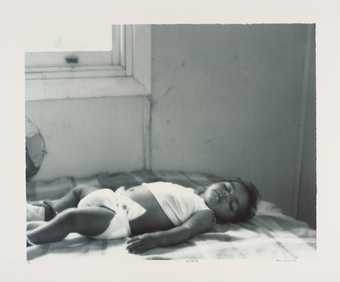
Not on display
- Artist
- Tracey Moffatt born 1960
- Part of
- Scarred for Life
- Medium
- Lithograph on paper
- Dimensions
- Image: 800 × 600 mm
- Collection
- Tate
- Acquisition
- Purchased 1998
- Reference
- P78106
Summary
Mother’s Day, 1975 is a photo-lithograph by the Australian artist Tracey Moffatt. The work depicts a girl from the shoulders upwards, her head blurred as if having moved from side to side. The caption accompanying the photograph states that ‘On Mother’s Day, as the family watched, she copped a backhander from her mother’. The girl’s pose and dynamic movements are a reaction to having been hit: her face is in profile, her mouth open in a scream, while her neck muscles strain and her hair flies outwards as her head is flung to the side by the force of the blow. The closeness of the camera to the girl’s face may suggest that the viewer occupies the position of the perpetrator – the girl’s mother.
Moffatt made this lithograph in her studio in Sydney in 1994. It is one of nine off-set lithographs taken from colour photographs printed on white wove paper and finished with a smooth matt surface. All nine are part of Moffatt’s 1994 series Scarred for Life 1994 (see also Tate P78100–P78105 and Tate P78107–P78108). The prints are not signed and no edition number is visible, and the artist has stated that the works can be shown either individually or as a group.
The work’s title reflects the fact that the distressing incident depicted in this work took place on Mother’s Day, and the date in the title, 1975, suggests the year according to which the photograph has been styled by Moffatt, who employs actors and constructed scenes to create her photographs. Curator Filippo Maggia has compared Moffatt’s photographic method to that of a film director, stating that she ‘often does not take the photographs herself but directs a sort of bona fide movie set that she organises and controls after having pictured it in her mind again and again, meticulously decomposing and recomposing it’ (Maggia 2006, p.12). As the artist has stated, ‘I often use technicians when I make my pictures. I more or less direct them. I stand back and call the shots.’ (Quoted in Maggia 2006, p.12.)
Moffatt’s photographic series often deal with themes such as race, gender and the politics of identity. Drawing on memories from the artist’s childhood, the Scarred for Life series mimics photo spreads from the American magazine Life, with their explanatory captions and focus on the family environment. The captions’ terse descriptions hint at the traumatic stories behind the images. Moffatt has commented: ‘a person can make a passing comment to you when you are young and this can change you forever. You can be “scarred for life” but it isn’t necessarily a bad thing. The photographs can be read as both tragic and comic – there is a thin line between both.’ (Quoted in display caption, Tracey Moffatt, Mother’s Day 1994, Tate P78106, http://www.tate.org.uk/art/artworks/moffatt-mothers-day-1975-p78106, accessed 28 August 2015.) Furthermore, Maggia has argued that the Scarred for Life series ‘gives us life as it is, the harshness and aridity of human relations, adolescence with its fears of not being accepted’ (Maggia 2006, p.13).
As the curator and writer Martin Hentschel noted in 1998, in Scarred for Life Moffatt’s subjects are ‘thoroughly unspectacular’ and ‘no gazette would print them’ (Hentschel 1998, p.26): a father telling off his son (The Wizard of Oz, 1956, Tate P78100), the rejection experienced by a daughter after an argument with her mother (Birth Certificate, 1962, Tate P78101) or the despondency felt by a teenager who cannot find a job (Job Hunt, 1976, Tate P78107). However, there is also explosive potential in the moments captured by the artist, which result in experiences that, as Hentschel observes, ‘are irrevocably implanted in the memory, from where they can break out at any time to attack the conscious’ (Hentschel 1998, p.26). Hentschel argues further that this potential becomes even more exaggerated in the viewer’s mind due to the relationship between the images and their captions: ‘the possible narratives visibly extend themselves if we bring the father and brothers and sisters into the story. All of this is left open in the hiatus between text and picture’ (Hentschel 1998, p.27).
Moffatt’s Scarred for Life works were followed in 1999 by a second Scarred for Life series, which was based on stories recounted to the artist by people she had met. Maggia has noted that this later series is ‘less aggressive than the first both in its images and in the accompanying texts, but it is every bit as effective, and perhaps even more universal’ (Maggia 2006, p.13).
Further reading
Martin Hentschel (ed.), Tracey Moffatt, exhibition catalogue, Kunsthalle Bern, Bern 1998, pp.26–7, reproduced pp.29 and 81.
Michael Snelling, Tracey Moffatt, exhibition catalogue, Institute of Modern Art, Brisbane 1999.
Filippo Maggia, Tracey Moffatt: Between Dreams and Reality, exhibition catalogue, Spazio Oberdan, Milan 2006, p.13, reproduced p.117.
Louise Hughes
August 2015
Supported by Christie’s.
Does this text contain inaccurate information or language that you feel we should improve or change? We would like to hear from you.
Display caption
Drawing on memories from the artist's childhood, these works mimic photo spreads from the American magazine Life. The terse captions hint at the traumatic stories behind the images. Moffatt has commented: 'A person can make a passing comment to you when you are young and this can change you forever. You can be "scarred for life" but it isn't necessarily a bad thing. The photographs can be read as both tragic and comic - there is a thin line between both.'
Gallery label, August 2004
Does this text contain inaccurate information or language that you feel we should improve or change? We would like to hear from you.
Explore
- emotions, concepts and ideas(16,416)
-
- formal qualities(12,454)
- furnishings(3,081)
-
- blind(14)
- actions: expressive(2,622)
-
- attacking(165)
- girl(1,079)
- black(796)
- health and welfare(696)
-
- child abuse(6)
- inscriptions(6,664)
-
- caption(358)
- printed text(1,138)
You might like
-
Tracey Moffatt The Wizard of Oz, 1956
1994 -
Tracey Moffatt Birth Certificate, 1962
1994 -
Tracey Moffatt Charm Alone, 1965
1994 -
Tracey Moffatt Heart Attack, 1970
1994 -
Tracey Moffatt Doll Birth, 1972
1994 -
Tracey Moffatt Useless, 1974
1994 -
Tracey Moffatt Job Hunt, 1976
1994 -
Tracey Moffatt Telecam Guys, 1977
1994 -
Tracey Moffatt [no title]
1997 -
Tracey Moffatt [no title]
1997 -
Tracey Moffatt [no title]
1997 -
Tracey Moffatt [no title]
1997 -
Tracey Moffatt [no title]
1997 -
Tracey Moffatt [no title]
1997 -
Tracey Moffatt [no title]
1997

